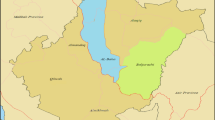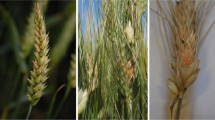Abstract
The effect of three fungal species on the nutrient profile of onions and cucumbers was studied. The species identities of the fungal isolates were initially determined based on macro- and micro-morphological characters as well as molecular confirmation, using the internal transcribed spacer region. The isolates were confirmed as Neocosmospora ramosa (MG682504), Aspergillus tamarii (MG682505) and A. violaceofuscus (MG682503). We then used each fungus to induce biodeterioration and performed proximate analysis of nutrient breakdown. We also assayed each fungus for the production of mycotoxins and performed anti-fungal susceptibility tests using fluconazole and voriconazole. We found that N. ramosa facilitated the highest rate of biodeterioration for onions and cucumber. Our anti-fungal tests revealed that non-aflatoxigenic A. tamarii was susceptible to voriconazole, but resistant to fluconazole. A. violaceofuscus (also non-aflatoxigenic) was found to be susceptible to both anti-fungals, while N. ramosa was resistant to both the anti-fungals tested. This study underscores the ability of fungi to degrade vegetables, and the need to focus on intervention through both chemical and best practices.



Similar content being viewed by others
References
Aboloma RI, Onifade AK, Adetuyi FC (2012) Effect of deterioration on the proximate composition of some fruits of the family Cucurbitaceae. J Microbiol Biotech Res 2(1):240–243
Abulude OA, Adeleke KO (2010) Comparative studies on nutritional composition of four melon seeds varieties. Pak J Nutr 9(9):905–908
Adebayo-Tayo BC, Odu NN, Esen CU, Okonkwo IO (2012) Microorganisms associated with spoilage of stored vegetables in Uyo Metropolis, Akwa Ibom state, Nigeria. Nat Sci 10(3):23–32
Al-Hatmi AMS, Meis JF, de Hoog GS (2016) Fusarium: molecular diversity and intrinsic drug resistance. PLoS Pathog 12(4):e1005464
AOAC (1990) Official methods of analysis of the association of official analytical chemists 15th ed. Arlington, Virginia
AOAC (1995) Official methods of analysis of the association of official analytical chemists 16th ed. Arlington, Virginia
Ara MAM, Khatun ML, Ashrafuzzaman M (2008) Fungi causing rots in onions at storage and market. J Bangladesh Agric Univ 6(2):245–251
Barth, M., Hankinson, T.R., Zhuang, H. and Breidt, F. (2009) Microbiological spoilage of fruits and vegetables. Compendium of the Microbiological Spoilage of Fruits and Vegetables, pp 135–183
Batista AC, Maia H d S (1955) Novos fungos do ar atmosferico. Anais da Sociedade de Biologia de Pernambuco 13:149–156
CDC (2017) Antifungal resistance https://www.cdc.gov/fungal/antifungal-resistance.html#twelve accessed 11 July 2017
Chuku EC, Emelike NJT (2014) Comparative studies on the nutrient composition of watermelon (Citrullus lunatus) and cucumber (Cucumis sativus) fruits and associated fungi. Niger J Mycol 6:109–116
Costa AM, Wanessa XR, Elaine K, Antonio RGM, Rosane MP (2008) Production of Tannase by Aspergillus tamarii in submerged cultures. Braz Arch Biol Technol 51(2):399–404
Crabol Y, Lortholary O (2014) Invasive mold infections in solid organ transplant recipients. Scientifica, 821969
De Lucca AJ (2007) Harmful fungi in both agriculture and medicine. Revista Iberoamerica Micologica 24:3–13
Fapohunda SO, Moore GG, Ganiyu OT, Beltz SB (2012) Toxigenic Aspergillus flavus and other fungi of public health concern in food and organic matter in Southwest Nigeria. Mycology 3(3):210–219
Goto T, Ito Y, Peterson SW, Wicklow D (1997) Mycotoxin producing ability of Aspergillus tamarii. Mycotoxins 44:17–20
Gregson L, Goodwin J, Johnson A, McEntee L, Moore CB, Richardson M, Hope WW, Howard SJ (2013) In Vitro susceptibility of Aspergillus fumigatus to Isavuconazole: correlation with Itraconazole, Voriconazole, and Posaconazole. Antimicrob Agents Chemother 57(11):5778–5780
Haapalainen M, Latvala S, Kuivainen E, Qiu Y, Segerstedt M, Hannukkala AO (2016) Fusarium oxysporum, F. proliferatum and F. redolens associated with basal rot of onion in Finland. Plant Pathol 65(8):1310–1320
Huang ZX (1990) Occurrence of cucumber wilt disease and identification of pathogen in Shanghai suburbs. Acta Agric Shanghai 6(2):57–62
James CS (1996) Analytical chemistry of foods. Blackie Academic and Professional, New York, pp 207–219
Javaid A, Niaz L, Shoaib A (2017) Effect of incorporation of leaf biomass of Coronopus didymus on management of basal rot disease of onion and plant physiology. Int J Agric Biol 19:445–452
Josiah AL, Efiuvwevwere BJO (2012) Microbiology of freshly harvested and market retailed cucumber. Asian J Sci Technol 4(11):71–73
Kamble R (2015) Aspergillus tamarii- A rare cause of nasal polyposis. Int J Curr Microbiol App Sci 4(3):588–592
Karina Q, De Sagun-Bella MD, Archimedes LD, Agahan MD, Leo DP, Cubillan MD, Noel S, Carino MD, De Mesa-Rodriguez RMT (2013) Antifungal activity of voriconazole on local isolates: an in-vitro study. Philipp J Ophthalmol 38:29–34
Kazemi A, Nowrozi H, Teshfam M, Teimorian S (2012) In vitro activities of amphotericin B, Itraconazole and Voriconazole against isolates of Aspergillus spp. Bull Env Pharmacol Life Sci 2(2):9–12
Lombard L, van der Merwe NA, Groenewald JZ, Crous PW (2015) Generic concepts in Nectriaceae. Stud Mycol 80:189–245
Majdah MY (2015) Studies on Fusarium wilt disease of cucumber. J Appl Pharm Sci 5(2):110–119
Mellado E, Garcia-Effron G, Alcazar-Fuoli L, Cuenca-Estrella M, Rodriguez-Tudela JL (2004) Substitutions at methionine 220 in the 14alpha-sterol demethylase (Cyp51A) of Aspergillus fumigatus are responsible for resistance in vitro to azole antifungal drugs. Antimicrob Agents Chemother 48:2747–2750
National Committee for Clinical Laboratory Standards (1998) Reference method for broth dilution antifungal susceptibility testing of conidium- forming filamentous fungi. Proposed standards M38-P. National Committee for Clinical Laboratory Standards, Wayne, PA
Norman JC (1992) Tropical vegetable crops. Arthur H. Stockwell Ltd Ilfracombe, Great Britain, pp. 252
O'Donnell K (1996) Progress towards a phylogenetic classification of Fusarium. Sydowia 48:57–70
Oko, A.O, Ubi, BE, Efisue AA, Dambaba N (2012). Comparative analysis of the chemical nutrient composition of selected local and newly introduced rice varieties grown in Ebonyi state of Nigeria. International Journal of Agriculture and Forestry, 2(2):16–23
Okoye NF (2013) Proximate analysis and protein solubility of four cucurbits found in Nigeria. Pak J Nutr 12(1):20–22
Onifade AK, Jeff-Agboola YA (2003) Effect of fungal infection on proximate nutrient composition of coconut (Cocos nucifera Linn) fruit. Food Agric Environ 1(2):141–142
Onimisi AO, Ovansa JU (2015) Comparative Studies on Nutritional Values of Four Varieties of Cucumber. International Conference on latest trends in Food, Biological Conference and Ecological Sciences (ICLTFBE’15) Oct 11–12 2015 Dubai UAE Conference www.iaast.org/upload/2852A1015056.pdf accessed 3 July 2017
Onwuka GI (2005) Food analysis and instrumentation: theory and practice, Naphathali prints, Nigeria, 95–96
Patel MH, Patel AM, Patel SM, Ninama GL, Patel KR, Lavingia BC (2011) Antifungal susceptibility testing to determine MIC of Amphotericin B, fluconazole and ketoconazole against ocular fungal infections. Nat J Comm Med 2:302–305
Popovski S, Celar FA (2013) The impact of environmental factors on the infection of cereals with Fusarium species and mycotoxins production. Acta Agriculturae Slovenica 101(1):105–116
Raju K, Naik MK (2007) Survey and assessment for the postharvest diseases of onion in north-eastern Karnataka. Karnataka J Agric Sci 20(1):164–165
Rodrigues P, Venâncio A, Kozakiewicz Z, Lima N (2009) A polyphasic approach to the identification of aflatoxigenic and non-aflatoxigenic strains of Aspergillus section Flavi isolated from Portuguese almonds. Int J Food Microbiol (2):187–193
Roopa VM, Suvarna VC, Natesh N (2014) Antimicrobial activity of plant extracts against post harvest spoilage of onions. Int J Curr Microbiol App Sci 3(5):388–394
Sahar N, Ahmed M, Parveen Z, Ilyas A, Bhutto A (2009) Screening of mycotoxins in wheat, fruits and vegetables grown in Sindh, Pakistan. Pak J Bot 41(1):337–341
Samson RA, Visagie CM, Houbraken J, Hong S-B, Hubka V, Klaassen CHW, Perrone G, Seifert KA, Susca A, Tanney JB, Varga J, Kocsubé S, Szigeti G, Yaguchi T, Frisvad JC (2014) Phylogeny, identification and nomenclature of the genus Aspergillus. Stud Mycol 78:141–173
Sani MA, Usman N, Kabir F, Kutama AS (2015) The effect of three natural preservatives on the growth of some predominant Fungi associated with the spoilage of fruits (mango, pineapple and cucumber). Global Adv Res J Agric Sci 4(12):923–928
Shovon B, Abida S, Muhammad HS, Muhammed AI, Ahtashom MM, Asaduzzaman A (2013) Analysis of the proximate composition and energy values of two varieties of onion (Allium cepa L.) bulbs of different origin: a comparative study. Int J Nutr Fd Sci 2(5):246–253
Siddiquee S, Yusuf K, Zainudin NIM (2010) Morphological and molecular detection of Fusarium chlamydosporum from root endophytes of Dendrobium crumenatum. Afr J Biotechnol 9(26):4081–4090
Szalay J (2017) Cucumbers: health benefits and nutritional facts. www.livescience.com/5000-cucumber-nutrition-total. Accessed 20 June, 2017
Therese KL, Bagyalakshmi HN, Madhavan HN, Deepa P (2006) In-vitro susceptibility testing by agar dilution method to determine the minimum inhibitory concentrations of amphotericin B, Fluconidazole and ketoconazole against ocular isolates. Indian J Med Microbiol 24(4):273–279
Umesh BK, Hemalatau K (2012) Incidence of post-harvest disease and airborne fungal spores in a vegetable market. Acta Bot Croat 71(1):147–157
van Diepeningen AD, Al-Hatmi A, Dalyan Cilo B, Giosa D, Barststra WJ, de Hoog GS (2015) Azole susceptibility and resistance in Fusarium spp. poster presentation P055. Mycoses 58(Suppl. 4):75–75 ISSN 1439-0507
Varga J, Frisvad JC, Kocsubey S, Brankoviocs B, Toth B, Szigeli G, Samson RA (2011) New and revisited species on Aspergillus section Nigri. Stud Mycol 69:1–17
Watson A, Napier T (2009) Diseases of cucurbit vegetables. Primefacts 832:1–6
Yaji ME, Aernan PT, Sule M (2016) Microorganisms associated with the spoilage of cucumber, garden egg and pawpaw in Makurdi metropolis, Benue Nigeria. Int J Recent Res Life Sci 3(1):11–18
Zhao J, Mei Z, Zhang X, Xue C, Zhang C, Ma T, Zhang S (2017) Suppression of Fusarium wilt of cucumber by ammonia gas fumigation via reduction of Fusarium population in the field. Sci Rep 7:43103. https://doi.org/10.1038/srep43103
Author information
Authors and Affiliations
Corresponding author
Rights and permissions
About this article
Cite this article
Aduroja, E.D., Moore, G.G., Beltz, S.B. et al. Induction of biodeterioration on vegetables by three fungal species. J Plant Pathol 101, 243–250 (2019). https://doi.org/10.1007/s42161-018-0175-y
Received:
Accepted:
Published:
Issue Date:
DOI: https://doi.org/10.1007/s42161-018-0175-y




